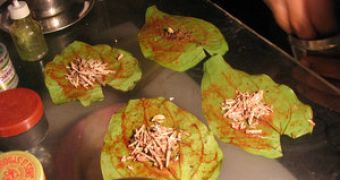Radio advertising encourages people to use it. On TV, magazines and newspapers, cinema stars present it as a product that makes you live an exciting and honorable life. Only an announcement written with small letters warn the consumers that its use affects their health. It's about a substance that produces dependency.
Paan is consumed in Southern Asia, especially in India and Myanmar. Its traditional formula consists in a mix of ground betel nuts (the astringent fruit of the betel palm, Areca catechu), tobacco and other spicy ingredients, but also sugar and fruits (cardamom saffron, (un)/roasted coconut pieces/powder, cloves).
The tobacco and the betel nut cause dependency. These ingredients are put in a betel leaf, which was previously ointed with a paste made of natural gum. The leaf is folded so that it wraps that filling and held together with a toothpick or a clove. Betel is a plant closely related to black pepper (also a spice) for the westerners and employed in traditional medicine and not related with the betel palm that produces the betel nut.
Paan chewing was connected to mouth hygiene, refreshing breath and offering it to guests represented a sign of hospitality. In other times it was part of a ritual of utmost sophistication. It was also eaten at traditional ceremonies and its consumption by the royal families was a must.
The most widespread is pan masal, which contains these ingredients, drought and mixed, packed in small packages which can be transported easily and consumed anywhere.
The chewing takes time and produces large amounts of saliva, which must be spitted from time to time. In most houses where pan is regularly consumed, there is a spittoon, but outside the dwelling, the "collecting" places are sidewalks and walls. For this reason, the staircases and corridors of many buildings in India present messy red and brown spots and in urban areas, paan consumers may have betel-stained teeth due to the habit.
In India, 10 % of the annual new cases of cancer are mouth cancers, twice the number of cases found worldwide. The main cause is paan chewing and in most cases this causes severe facial deformations. The main culprit for this is the betel nut. In combination with tobacco (a cancer inducing by itself), this effect is boosted.

 14 DAY TRIAL //
14 DAY TRIAL //